Originally published in 2011 in VeloceToday.com
Preparations for the 1950 expedition to the Glen included ordering a British Cromwell crash helmet and obtaining a seat belt from a local Army/Navy surplus store. Dad assembled all his Whitworth tools and arranged to drive in tandem with his friend Norm Couty. Couty and his wife were in his new Olds and it had plenty of trunk space for our extra gear. He had also thrown in a lengthy and stout rope ‘just in case’ the SS100 had problems.
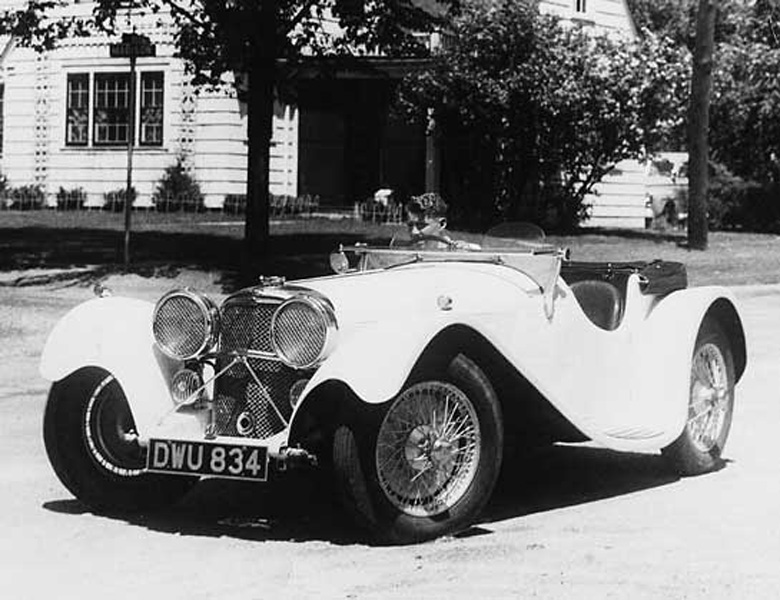
The Jag SS100 didn\’t make it to the Glen. My poor father\’s hopes and dreams lay in a pasture in Ontario. But along the way, someone had to share the driving chores in the SS100, and often it was a young Eric Davison. Charlie Davison photo.
We left Birmingham, Michigan very early on a Friday morning figuring that if we arrived mid-afternoon we would have the rest of the day and all Saturday to learn the course. When we cleared Canadian customs at the Windsor Tunnel it was probably 5:00 AM and still dark. We were outside the city limits within a few more minutes and as soon as the roads were clear Dad put his foot in it. After about a half hour of speeds around 90 there was an ominous drop in oil pressure followed immediately by the sound of a bearing gone south.
There was nothing to do. Going back would have caused all of us to miss the race and the car could not go on. So, the SS100 was pushed into a field surrounded by sleeping cows. A note was left on the windshield stating that we would be back to collect the car on Sunday evening. I could not think of a more devastating blow to my Dad. It was really heartbreaking.
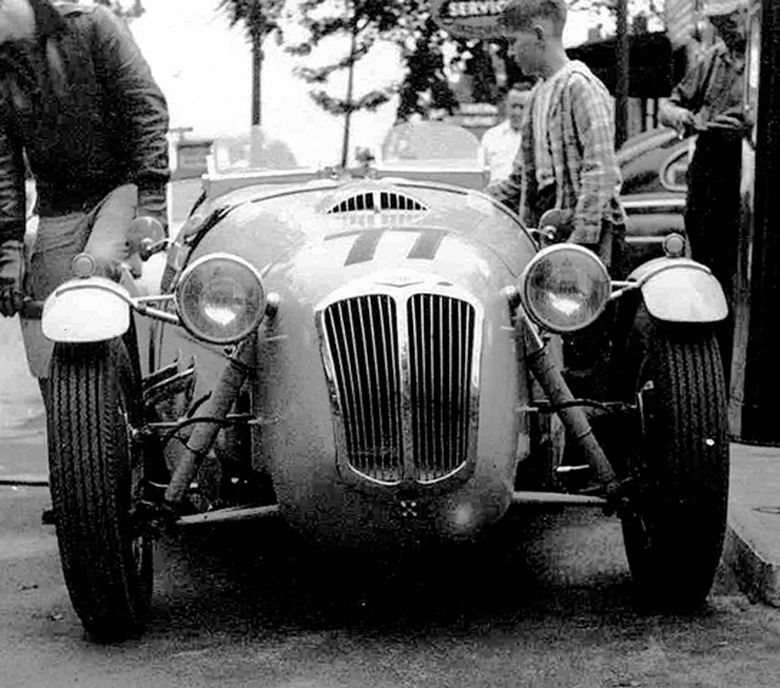
Charles Boyton III placed fifth in the Seneca Cup with this Frazer Nash Le Mans replica. The snarl from the engine was unforgettable. Frank Shaffer photo.
The Seneca Cup race had been expanded to 15 laps. It was won by Phil Walters driving a Healey Silverstone that had been fitted with a Cadillac engine. The owner was Briggs Cunningham. Erwin Goldschmidt was second in a Cadillac Allard and the best sounding car of all time was the Frazer Nash LeMans Replica that finished fifth. That car had a snarl that reverberated from the far point of the Glen falls all the way back into town.
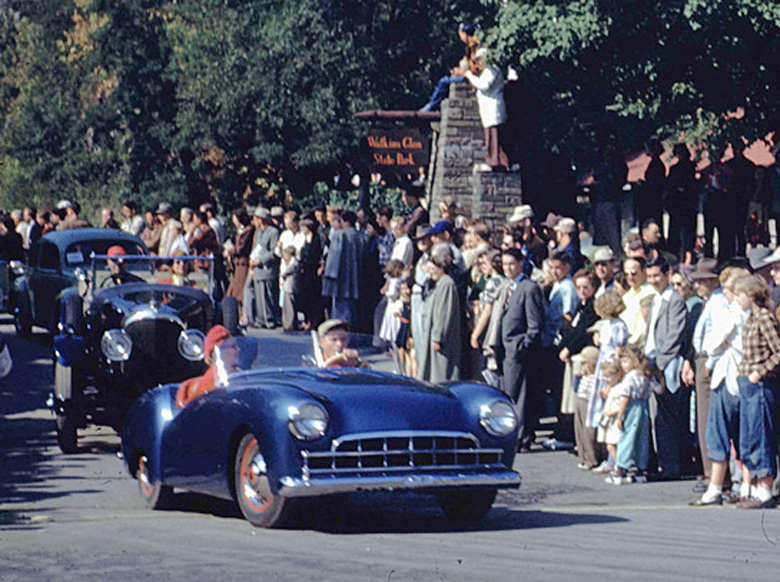
Farago takes his very special Fiat 1100 on the parade at the Glen. For more about Farago click on the photo. Harold Lance photo.
Our good friend Paul Farago won his class driving his own creation, an 1100 Fiat with a body that he fashioned himself. The beautiful little barchetta also won a blue ribbon in the concourse. The winner of that race was the first that someone was able to use the rules to gain an advantage. Rowland Keith was an MG TC driver with imagination. The rules stated that if a car was supercharged it moved up a class. Keith sleeved his MG down to below 1100 cc, the cut-off point for the class and then added a supercharger and that put him back up a class to where he was running against standard MGs of 1247cc. It was no contest.
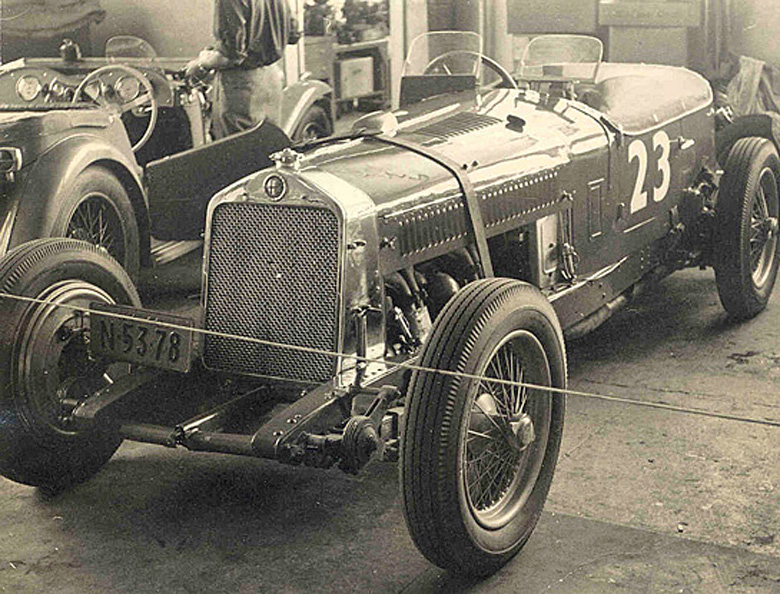
David Felix entered this 1932 Alfa 8C2300 but did not start in the Seneca Cup event. It was driven by George Huntoon in the 1949 event. The car is S/N 2211125, originally a Monza with a later body by Ranelagh of London. It has a long and interesting history and still exists with a new Monza body. Frank Shaffer photo.
The feature race was won by Erwin Goldschmidt. His entry was controversial. Goldschmidt was a Jew and Jews were not welcome at that time into the waspish SCCA. However, Goldschmidt was a member of another club and he petitioned the SCCA to allow members of that club to race. He was not allowed to race in an SCCA event because he was not a member but he was not allowed to become a member because he was a Jew. Smarter heads prevailed and his entry, albeit supported by membership in another club, was accepted with the proviso that members of other clubs started at the back of the pack. Goldschmidt delightfully returned the favor by winning the race.
Sadly, the race also marked the death of Sam Collier, who fatally crashed the Cunningham Ferrari 166 on lap two. It was a further bit of bad news so close the the death of our friend Bob Collins at Edenvale.
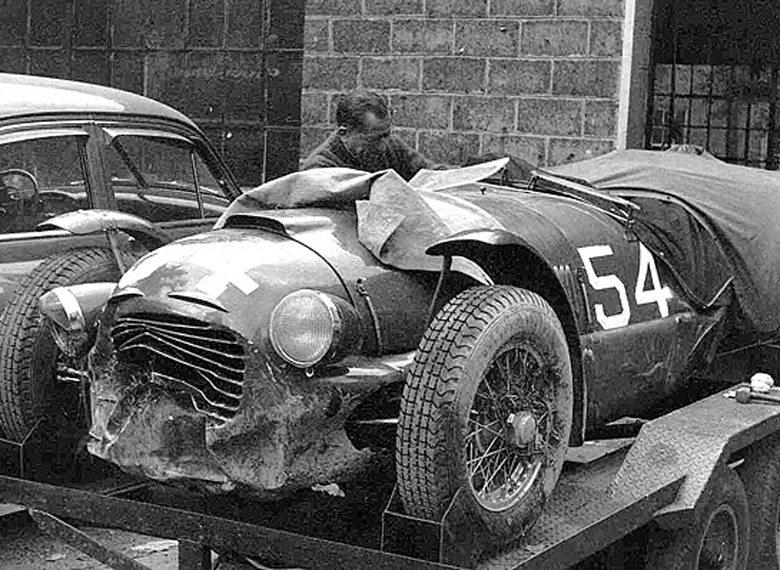
Alfred Momo ties down the wrecked Ferrari 166M to the trailer after the feature race. Sam Collier tragically died in the car after leaving the track on lap two of the main event. Frank Shaffer photo.
During the weekend of the racing the town was a wild assortment of cars, drivers and spectators. One night I found myself outside a restaurant when Dave Garroway exited. Being a cheeky kid I stepped right up and introduced myself explaining that my Dad’s was the other SS100 that had been entered. I explained the fate. Garroway, a really fine gentleman and serious enthusiast told me to bring Dad around so they could talk. He also expressed dismay at the fate of our car and stated that it was too bad we could not have brought it the rest of the way. He had parts, tools and a willing crew and the car could have been on the track. I have been a fan of his ever since.
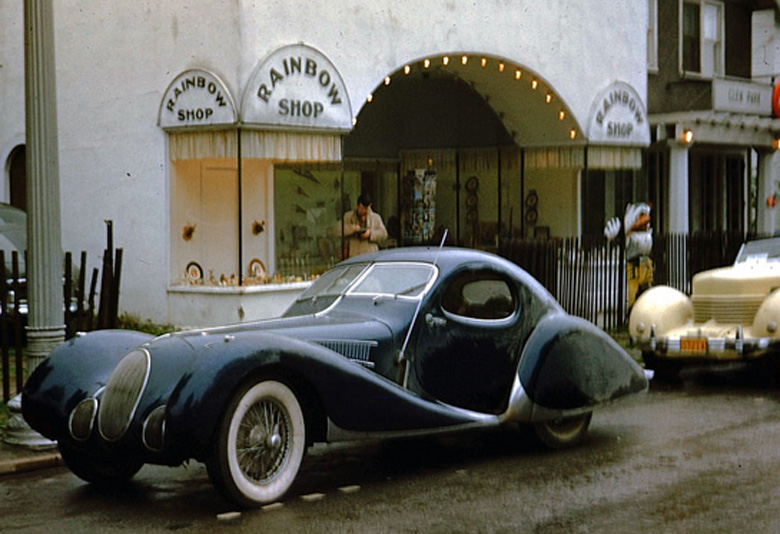
The Stevens Talbot Lago sits outside of a local restaurant, a picture of automotive perfection. In 1951 the car was offered for sale at $5000; in 2005 changed hands at a Christies Auction for $3.5 million. Eric Davison photo.
The most exciting car that I saw was the Talbot Lago tear drop coupe. It was owned by the noted industrial designer Brooks Stevens and driven by James Florio. It was the most beautiful car that I had ever seen and remains to this day my picture of automotive perfection. Also there but just parked on the street was a V-12 Delahaye Type 145 with a Chapron body. It had been based on a race car chassis but was all dressed up in beautiful French style.
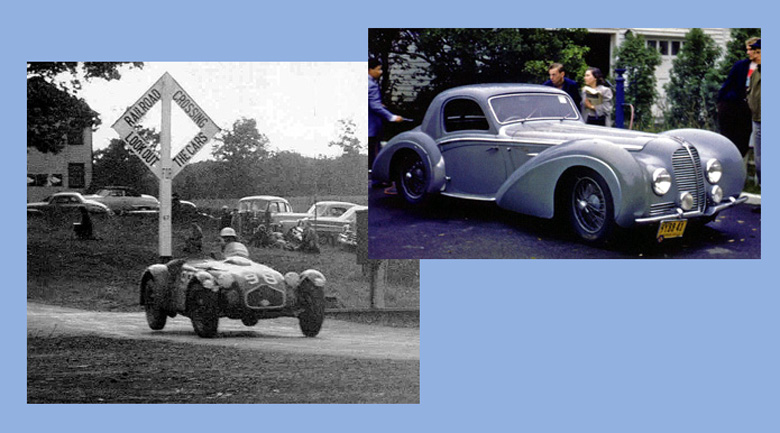
Watkins Glen attracted the greatest cars on the road. Goldschmidt won in the Cad Allard. Frank Shaffer photo. This Delahaye 145 is one of several cars built with the V12 Grand Prix engine and chassis. It is now owned by the Mullin Museum in California. Harold Lance photo.
When we arrived back at the field where the SS was stashed it was intact and the cows had not licked off the paint. There was a note under the windshield from a man in Chicago who wanted to buy the car. Dad put it into his pocket while we lined the car up behind Couty’s Olds and affixed the tow rope. We were probably about 90 miles from home and Couty was a fast driver. I was assigned to kneel rearward on the back seat and convey conditions between Dad and Couty. Naturally Dad would get a bit nervous when we passed cars or went tearing around a curve. A tap to the Jag’s brakes would snap the rope and each time it was retied the rope got shorter. Eventually it was hard to see anything other than the windshield and my father’s terrified face from my perch. It would not have taken much to put the beautiful Jag radiator into the back bumper of the Olds. Dad kept signaling for Couty to slow down. I would pass that on to Couty and he would snarl at me to stop whining. It was a scary trip and while we made it home with no incident it was a miracle.
Note: The lead photo by Harold Lance is a rare Italmeccanica.
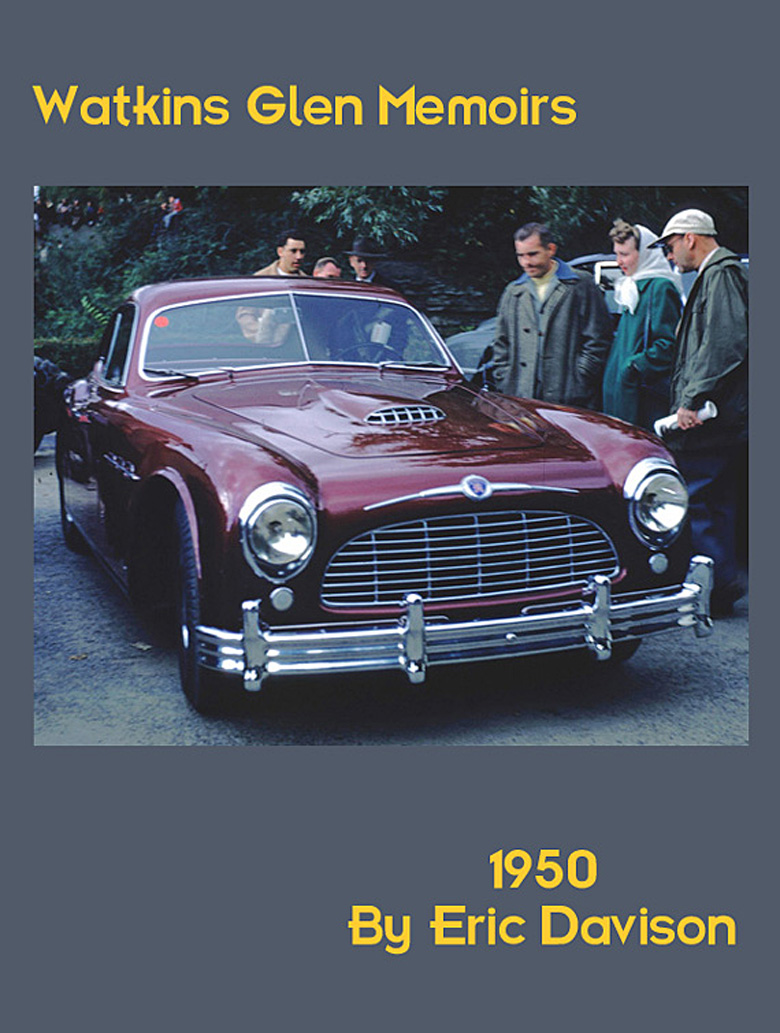
Having been born and raised in Geneva (the other end of Seneca Lake from WG) – I came under the spell of the races but not until 1967 when a friend of the family -who was an SCCA grid marshal, took me to my first Grand Prix. The original street races have always been one of those things I needed to study up on –but there were always other things — like LeMans and Formula 2 — but now I must dive deeper into that history — thank you so much for these remembrances!!
Steve,
We bet you’ll love the rest of Eric’s memoirs…
Editor
The Stevens Talbot Lago photo reminds me of my first race — at Edenvale (in Ontario) in 1955 when I was still too young to drive. It was my first chance to see the sports cars I had been reading about in the magazines like Road & Track and Sports Cars Illustrated.
I can’t be sure about this but, as I remember it, I saw a car parked there that looked just like the Stevens Talbot Lago. I suppose it might have been at that race …
I was enchanted by the look of the car then — and I still am today over 60 years later …
Love that Fraser Nash !
Ted and Shirley Boynton of Winnekta, Illinois.
As I understand it his car was the 1st one in America and had
been the show car for British Motor Show of all new products
held in New York City Spring of 1950.Boynton previously raced
Healey Silverstone, and made debut with the Le Mans Rep at
Elkhart Lake 1950
Le Mans rep originally known as ” High Speed” model until
motorcycle racer Norm Culpan drove his own Red car to 3rd place
at the 24 hour race in 1949.
Jim Sitz
That wonderful Talbot Lago coupe was better known in California
as from the Tommy Lee stable -he had 3 of them !
When I saw the car in 1949 it belonged to Roger Barlow who\
operated International Motors on Sunset Boulevard and had other
exoctic cars. The Talbot Lago was metallic blue and his personal drive
1950 at Watkins Glen, the car driven by James Flora
faithfully
Jim Sitz
I went to the Cunningham Museum in the early 70s and since no one else was there the Curator, John Burgess gave me a personal car by car tour of the collection. When we were done with that he took me into the shop where the Ferrari 166M was being restored. John told me that it had been restored after the accident but they had found it was over one inch shorter on one side than the other so it was being completely restored again. A footnote to history……..